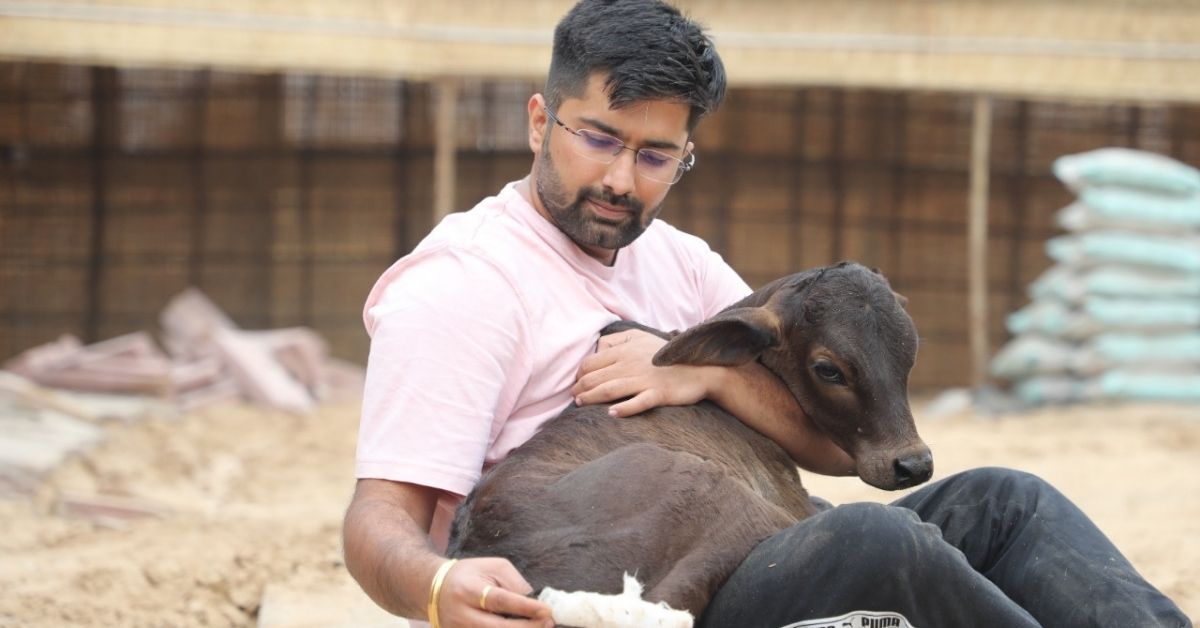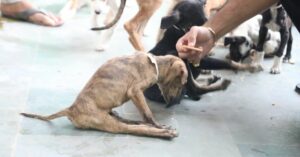Techie Turns His Farmhouse into Free Hospital & Shelter for Animals, Helps 50000
Kuldeep Khatri began Dog Home Foundation in 2020 for strays around Jodhpur. His team of 40 runs a 24/7 clinic and ambulance, and provides a variety of treatments.

One day, back in 2017, Kuldeep Khatri decided to go for a spin in his car. Seconds after Kuldeep switched on his engine, he heard a yelp. The sound’s source was a pup with an injured leg, who had been resting under his car to escape the summer heat.
Kuldeep ran from pillar to post across Jodhpur for two days to get the animal some help. The experience opened his eyes to a little-considered reality – few people knew how to help a stray. “I could not find a good government shelter where the pup could get the medical assistance,” says the 30-year-old.
And so began an idea – to build an institution for strays.
And though he could not raise the funds needed for an animal hospital, he did have another option – the land he had purchased for a farmhouse.
“I realised I could always get comforts in my own home,” Kuldeep says, but voiceless strays had no way of getting help unless someone went out of their way to help them.
The land, where a farmhouse would have come up, cost him Rs 80 lakh. But he turned a blind eye to that and began his shelter home and hospital for animals.
Helping Jodhpur’s stray animals get a new lease on life
With Dr Kalu Ram, a vet, and Pramod Sankhla, a businessman he met when looking for help for the injured dog, Kuldeep began the ‘Dog Home Foundation’ in 2020.

The three continue to work in their professional capacities (Kuldeep works in the IT sector) while tending to the functioning of the hospital.
And it is an approved and legal foundation rather than an informal affair. Kuldeep went to great lengths to even get Foreign Contribution (Regulation) Act, 2010 approvals so that the foundation would continue for many years – with or without Kuldeep.
Today, the hospital has over 40 people working for it. The hospital has managed to help more than 48,300 stray animals in various capacities, such as through rescues, medical assistance, food, etc.
The hospital runs 24/7 for free for any animal. The foundation can take X-ray and ultrasonography images, run blood tests, and conduct various therapies like physiotherapy and hydrotherapy.
Critically, they also run a free ambulance service for quick medical aid.
The animals are thoroughly looked after regarding their food and water needs. A tube well at the farmhouse satisfies the drinking needs of the animals. However, due to near-drought conditions, Kuldeep says they are trying to source water from other places.
Pramod Sankhla, who was also involved in setting up the hospital with Kuldeep, says they go the extra mile – literally.
“Many shelters and NGOs only operate within a 10 km radius for animal rescues. However, when we get a call for a rescue, we do not dismiss it on account of distance,” he says.
A glimpse of the farmhouse turned animal hospital
The shelter, Kuldeep explains, has ten rooms. These include the food room where chapatis are made for the animals, and dry dog food bags are stored. “Food is put out for the animals at 8 am, then at 2 pm they have Pedigree, followed by biscuits at 5 pm and chapatis and milk at 8 pm,” he says.
The other rooms include a kitchen, an x-ray room, an operation theatre, a hydrotherapy room, a room for storing medicines, a room to store fodder for large animals like cows and a vacant room which Kuldeep is planning on turning into a space where animals can be cremated in a dignified way.
At any part of the day, medical assistance is available for animals brought in. Six ‘Live Stock Assistances’ (LSAs) and two vets provide this. Nothing is voluntary, as every person at the shelter is paid a salary.
The vets operate in shifts, and there are rooms at the back of the farmhouse where they can stay during their shift.
Housing so many different animals under one roof could be a challenge. But, when questioned about this, Kuldeep says, “not really.”
“People who rescue stray animals usually come to us with a warning that the animal may behave aggressively,” he says. “But when the animal settles down, they get along very well with the others at the shelter. Animals that are critical or badly injured are kept in cages by themselves.”

“Once the animal recovers, we take them back to where we rescued them from,” he says.
If the animal is disabled, it continues to remain at this hospital.
Every day, the team sees an inflow of about 40 dogs at the shelter and tends to approximately 90 stray dogs on the streets of Jodhpur.
“When someone sees a stray dog, they call us, and we send an LSA to the area for treatment,” he explains. “If the animal is badly hurt, the LSA calls for an ambulance from the Dog Home Foundation. The ‘Eco Van’ that arrives on site is a compartmentalised one that can carry four dogs at once.”
A hydraulic ambulance for the larger animals can load the animal onto the van through a lever.

Dr Yashank, a vet at the hospital, says that they tend to many kinds of injuries. “These range from hit-and-run cases to dog bites to spinal injuries that these animals sometimes experience. We treat with injections, dressing, and painkillers when it is a wound. Whereas, when the animal requires internal intervention, it is done in the operation theatre,” he says.
While the hospital claims it has a ‘success rate’ of 98 per cent, Kuldeep says they face a significant funds crunch.
“The number of strays exponentially increases. And naturally, we try to treat and house all the strays who come to us. But as the number of casualties increases, the funds needed rise.”
“People do not believe in donations. Hence if you are planning on starting something in this capacity for strays, ensure you have funds in your pocket to do so,” he says, adding that while 30 per cent of the donations have come from crowdfunding, 70 per cent are his contribution.
If you wish to help, donate or report any injured strays (in Jodhpur), you can contact the team through their Instagram or Facebook pages or call their helpline: 9352727457
(Edited by Vinayak Hegde)
If you found our stories insightful, informative, or even just enjoyable, we invite you to consider making a voluntary payment to support the work we do at The Better India. Your contribution helps us continue producing quality content that educates, inspires, and drives positive change.
Choose one of the payment options below for your contribution-
By paying for the stories you value, you directly contribute to sustaining our efforts focused on making a difference in the world. Together, let’s ensure that impactful stories continue to be told and shared, enriching lives and communities alike.
Thank you for your support. Here are some frequently asked questions you might find helpful to know why you are contributing?


This story made me
-
97
-
121
-
89
-
167













